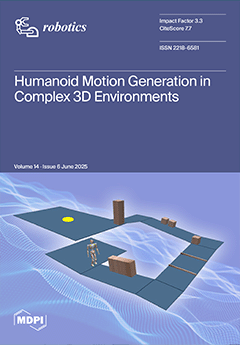This paper introduces a robust neural adaptive MIMO control strategy to improve the stability and adaptability of bipedal locomotion amid uncertainties and external disturbances. The control combines nonlinear dynamic inversion, finite-time convergence, and radial basis function (RBF) neural networks for fast, accurate trajectory
[...] Read more.
This paper introduces a robust neural adaptive MIMO control strategy to improve the stability and adaptability of bipedal locomotion amid uncertainties and external disturbances. The control combines nonlinear dynamic inversion, finite-time convergence, and radial basis function (RBF) neural networks for fast, accurate trajectory tracking. The main novelty of the presented control strategy lies in unifying instantaneous feedback, real-time learning, and dynamic adaptation within a multivariable feedback framework, delivering superior robustness, precision, and real-time performance under extreme conditions. The control scheme is implemented on a 5-DOF underactuated
robot using a
platform with a sampling rate of
. The experimental results show excellent performance with the following: The robot achieved stable cyclic gaits while keeping the tracking error within
under nominal conditions. Under severe uncertainties of trunk mass variations
, limb inertia changes
, and actuator torque saturation at
, the robot maintains stable limit cycles with smooth control. The performance of the proposed controller is compared with classical nonlinear decoupling, non-adaptive finite-time, neural-fuzzy learning, and deep learning controls. The results demonstrate that the proposed method outperforms the four benchmark strategies, achieving the lowest errors and fastest convergence with the following:
,
,
,
, and
. These results demonstrate evidence of high stability, rapid convergence, and robustness to disturbances and foot-slip.
Full article





